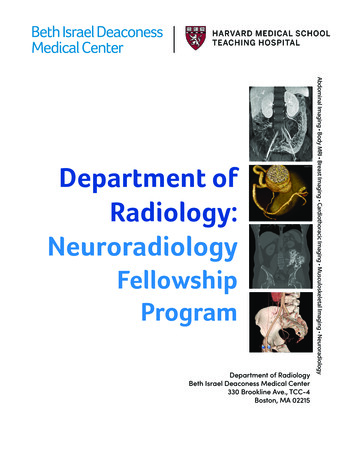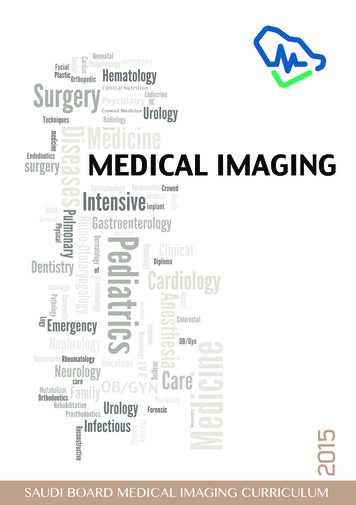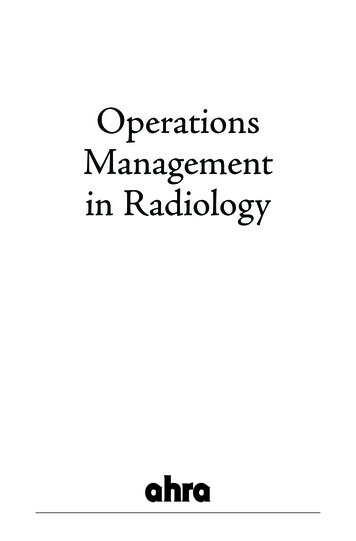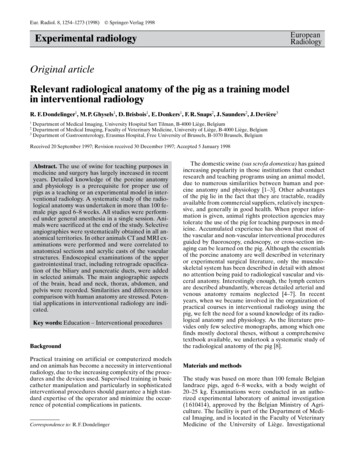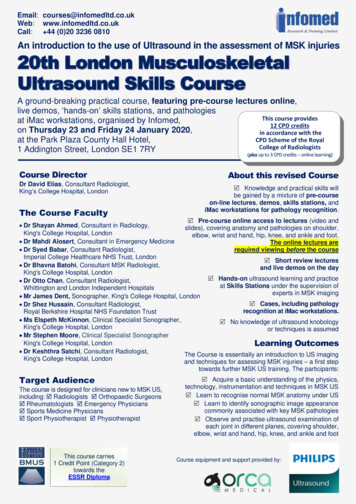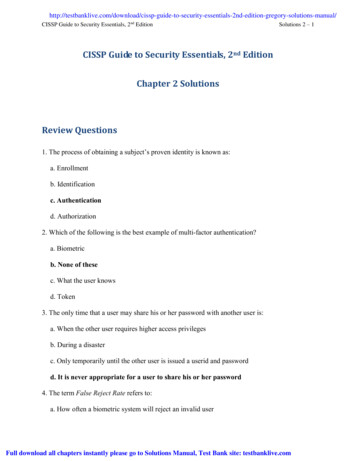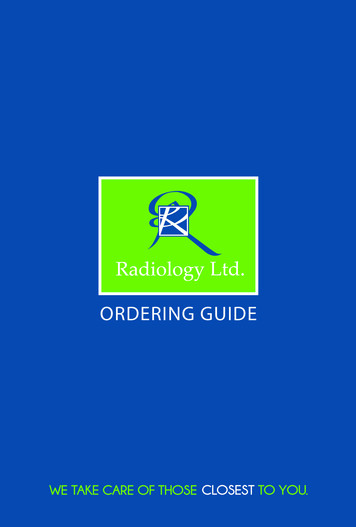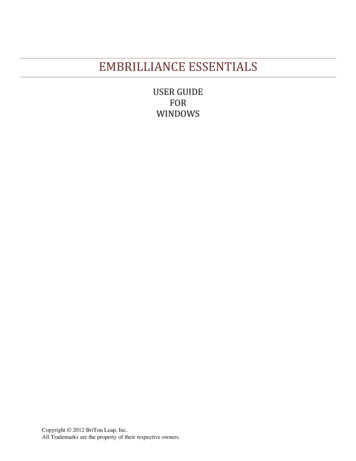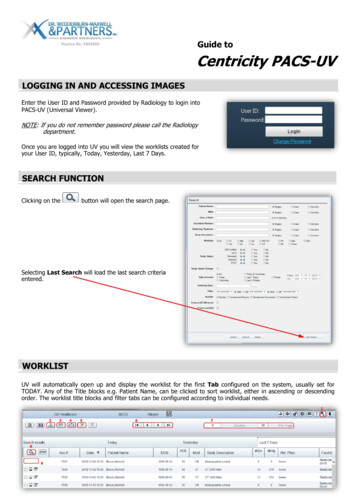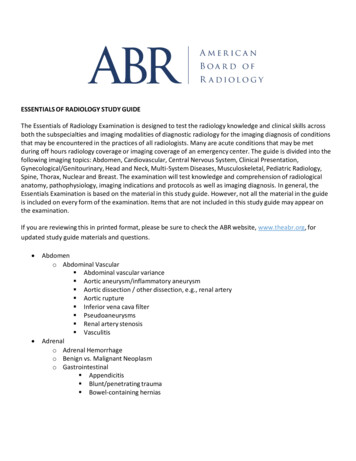
Transcription
ESSENTIALS OF RADIOLOGY STUDY GUIDEThe Essentials of Radiology Examination is designed to test the radiology knowledge and clinical skills acrossboth the subspecialties and imaging modalities of diagnostic radiology for the imaging diagnosis of conditionsthat may be encountered in the practices of all radiologists. Many are acute conditions that may be metduring off hours radiology coverage or imaging coverage of an emergency center. The guide is divided into thefollowing imaging topics: Abdomen, Cardiovascular, Central Nervous System, Clinical Presentation,Gynecological/Genitourinary, Head and Neck, Multi-System Diseases, Musculoskeletal, Pediatric Radiology,Spine, Thorax, Nuclear and Breast. The examination will test knowledge and comprehension of radiologicalanatomy, pathophysiology, imaging indications and protocols as well as imaging diagnosis. In general, theEssentials Examination is based on the material in this study guide. However, not all the material in the guideis included on every form of the examination. Items that are not included in this study guide may appear onthe examination.If you are reviewing this in printed format, please be sure to check the ABR website, www.theabr.org, forupdated study guide materials and questions. Abdomeno Abdominal Vascular Abdominal vascular variance Aortic aneurysm/inflammatory aneurysm Aortic dissection / other dissection, e.g., renal artery Aortic rupture Inferior vena cava filter Pseudoaneurysms Renal artery stenosis VasculitisAdrenalo Adrenal Hemorrhageo Benign vs. Malignant Neoplasmo Gastrointestinal Appendicitis Blunt/penetrating trauma Bowel-containing hernias
Bowel ischemia/pneumatosis Bowel obstruction Diverticulitis Epiploic appendagitis Gallstone ileus GI tumor Infection – e.g., C. difficile Inflammatory bowel disease Intussusception Malrotation Shock bowel Volvulus – gastric/colonic/small bowelo Hepatobiliary Benign disease as mimic of metastatic disease Benign vs. malignant gallbladder disease Cholangiocarcinoma Cholelithiasis, cholecystitis, choledocholithiasis Cirrhosis/portal hypertension/hepatocellular carcinoma Hepatic abscess Metastatic disease Trauma – lacerations/contusion/rupture Hepatitiso Mesentery, Peritoneum, Retroperitoneum Omental infarct Peritoneal carcinomatosis Retroperitoneal hemorrhage Trauma – mesenteric hematomao Pancreas Pancreatitis (abscess, pseudocyst) Pancreatic neoplasm Pancreatic traumao Spleen Trauma/ruptureo Urinary Tract Bladder trauma Hydronephrosis Pyelonephritis/emphysematous pyelonephritis/pyelitis Renal abscess Renal neoplasm Renal transplant complications Renal trauma Stone diseaseCardiovascularo Aorta Aneurysm Dissection
Intramural hematomao Heart Congestive heart failure Pericardial effusion and tamponade Valvular heart diseaseo Technique-Related Aortic and thoracic vascular imaging protocols CT, MR, and nuclear radiology cardiac imaging protocols Tubes and lines Central Nervous Systemo Brain and Its Coverings Brain herniations Epidural hematoma Primary brain tumor including glioblastoma Headache Hydrocephalus Infarction (arterial, venous) Infection (cerebral abscess, subdural empyema, epidural abscess) Intracranial tumors Intraparenchymal hematoma (e.g., hypertensive) Metastases Nonaccidental trauma (especially child abuse) Skull fracture Subarachnoid hemorrhage Subdural hematoma Toxic/metabolico Spinal Cord Disk herniation Spinal cord compression (especially acute) Trauma (contusion, hemorrhage, epidural hematoma)o Technique-Related CT physics – window & leveling, artifacts, diagnosis MR sequencing (for diagnosis of stroke, etc.) Protocol: when to add contrast to CT Protocol: when to use unenhanced CT Protocol: when to add contrast to MRI Protocol: when to pick MRI over CTo Clinical Presentations Abdominal pain Back pain Chest pain GI bleeding Headache Hematuria Hemoptysis Trauma
Gynecological, Genitourinaryo Female Conditions Benign vs. malignant ovarian masses/cysts Ectopic pregnancy Hydrosalpinx Ovarian torsion Pelvic inflammatory disease/tubo-ovarian abscess Placental abnormalities Retained products of conception Uterine neoplasmo Male Conditions Benign vs. malignant testicular lesions Orchitis/epididymitis Testicular trauma Head & Necko Airway Compromiseo Facial Fractureso Infections (abscess, cellulitis, epiglottitis)o Intraorbital Masseso Lymphadenopathyo Orbital Infectionso Sinusitis (acute, chronic, complications)o Soft Tissue Injuries (hemorrhage, globe injuries)o CT Protocols for Face and Neck Trauma/Emergencieso Vascular Compromise, Vascular Injuries Multi-System Diseaseso Atherosclerosiso Connective Tissueo Diabeteso HIV/AIDSo Iatrogenic Complicationso Infectiono Long-term & acute complications of chemotherapy/radiation therapyo Smokingo Substance Abuseo Tuberculosis Musculoskeletal (MSK)o General MSK Traumatic Conditions Compartment syndrome Insufficiency fractures Patterns of sports injuriesMSKInfections/Inflammations o Discitiso Diabetic Foot—Neuropathy vs. Infectiono Necrotizing Fasciitiso Osteomyelitis—Acute, Chronic
o TuberculosisMSK Neoplasmso Benign vs. Malignanto Indications for CT, MRI, PET, PET/CTo Indolent vs. Aggressiveo Primary vs. MetastaticTechnique-Relatedo CT and MRI protocols for suspected extremity/pelvic injurieso CT and MRI protocols for suspected spine injuryOther MSK Conditionso Arthritiso Avascular Necrosiso Collagen Vascular Diseaseso Developmental/Anatomic Variantso Iatrogenic/Postoperative Arthroplasty (complications, loosening, motion) Hardware failureo Low Back Pain Indications for imaging Imaging protocols (radiographs, CT, MRI)o Osteoporosiso Spondylolisthesis—Classification, Grading, Dynamic StudiesTraumao Cervical Spine Cervical spine common fractures/dislocations C1 burst Compression Facet subluxation/dislocation Occipital condyle Odontoid Clinical criteria for cervical spine trauma imaging Canadian Spine Rules NEXUS criteria Indications for CT, MRI, CT arteriography Indications for radiographic examination Mechanism: flexion vs. extension injurieso Lower Extremity Ankle Fracture types Knee Indications for CT and MRI MRI of anterior cruciate ligament, meniscus injuries Patellar subluxation, patellar fractures Radiographic findings of trauma Tibial plateau fractures/ intercondylar injuries Role of CT and MRI
Foot Lisfranc fracture Hip Indications for CT, MRI Radiographic positioning for hip trauma Risks for avascular necrosis Trochanteric avulsions Types of hip fractures Other Lower Extremity Calcaneal fractures and associated injuries Maisonneuve recognition Talar dome and talar waist fractures, avascular necrosis risks Pelvis Define anterior and posterior columns Femoral head dislocation Indications for CT and MRI Mechanisms of injury Patterns of injury- Vertical shear, compression, open book Pelvic-ring trauma Sacral fractures, sacroiliac joint disruption Thoracolumbar Spine Acute vs. chronic Burst fractures Chance fractures- Facet subluxations/dislocations- Indications for thoracolumbar spine imagingo Upper Extremity Clavicle Sternoclavicular dislocation Elbow Imaging protocols- Radial head-capitullum views Location of fractures by age/mechanism of injury (Peds) Olecranon fracture (Galeazzi & Monteggia) Radial head fracture, Supracondylar facture Shoulder Dislocations Fractures Imaging protocols (radiographs, CT, MRI) Indications for CT and MRI Wrist Carpal fractures - scaphoidPediatric Radiologyo Abdomen/Pelvis
Appendicitis – ultrasound CT Bowel obstruction Hypoperfusion complex Intussusception Malrotation Pregnancy Wilms, Ewing, neuroblastoma Testicular torsion/epididymitiso Airway Emergencies Epiglottitis & croup Foreign body aspiration Retropharyngeal abscesso Central Nervous System Hypoxic/ischemic injury Increased intracranial pressure – hydrocephalus Mastoiditis/meningitis Skull fractureo Chest Pneumomediastinum Pneumothorax Round pneumonia Thymuso Child Abuse CNS trauma Skeletal trauma Soft tissue traumao General Pediatric Considerations Congenital disorders Developmental dysplasia of hip Informed consent Radiation protection/dose reduction/ALARA Sedation/monitoring VACTERL associationo MSK Developmental/anatomic variantso Skeletal Discitis Elbow fracture/dislocation Osteomyelitis Salter-Harris injury Septic joint Slipped capital femoral epiphysisSpine (See also MSK section)o Cervical Spine Fractures/Dislocations Congenital/developmental pathology: Arnold-Chiari malformations, spina bifida
o Infections: Discitis Osteomyelitiso Primary and Metastatic Neoplasmso Technique-Related: CT protocols for spine trauma/emergencies MRI protocols for spine trauma/emergencieso Thoracic and Lumbar Spine Fractures/DislocationsThoraxo Airway Conditions Bronchiectasis Foreign body Small airway disease Tracheal pathologyo Anatomy and Normal Variants Airways Aortao Chest Trauma Aorta Heart Lungs Skeleton (flail chest, thoracic spine fracture on portable chest film)o Intensive Care Chest Radiographs Catheters, tubes, monitoro Interstitial Pulmonary Disease Idiopathic interstitial pneumonias Pneumoconiosis Sarcoidosis Signs & patterns – high-resolution CT Smoking-related interstitial lung diseaseo Lobar Atelectasiso Lung Mass, Pulmonary Nodules Benign tumors Malignant tumors Neoplasm management Solitary & multiple pulmonary noduleso Mediastinum Infection Masses Pneumomediastinumo Pulmonary Vasculature Arterial venous malformations Pulmonary embolism Shunts Pulmonary edemao Pleural Disease
Empyema Hemothorax Pneumothorax Pleural effusion Tumorso Pulmonary Infections Lung abscess Pneumonia Tuberculosiso Technique-Related Airway imaging CT protocols for the thorax Interstitial lung disease protocols Pulmonary embolism protocols Nuclearo Interpretation Bone scans Renal scans PET scans Ventilation-perfusion scans Hepatobiliary scans Bleeding scans Brain death Thyroid Cardiac White cell scans Sentinel nodeso Management & Methodology Patient preparation Radiopharmaceuticals Protocols Nonradioactive pharmaceuticals Hardware and softwareo Risk Radiation exposure to patients Radiation exposure to public and staffo Quality Assurance Breasto Interpretation Spiculated masses (mammography, MRI, ultrasound) Architectural distortion (mammography) Fibroadenomas (mammography, MRI, ultrasound) Cysts (mammography, MRI, ultrasound) Inflammatory breast cancer and other causes Skin thickening, e.g., mastitis (mammography) Malignant calcifications (mammography)
Benign calcifications (e.g., fibroadenoma, skin, milk of calcium, fat necrosis, oil cysts)(mammography) Fat-containing masses (mammography) Nodes (mammography and ultrasound, benign and malignant) Postsurgical breast (mammography) Gynecomastia (mammography, ultrasound) Implants (mammography, ultrasound, MRI) Basic quality assurance of inadequate studieso Management High risk screening guidelines Low risk screening guidelines Image negative palpable mass Palpable masses Cat lesions Significance of change and stability (high and low risk lesions) Mastitis Indications for core (stereotactic, ultrasound, MRI) versus surgical biopsy Management of nonconcordant core biopsy resultso Risk Radiation dose from mammography Breast MRI risk (contrast, metal, etc.) Procedural risko Terminology and methodology Meaning of BI-RADS categories Basic BI-RADS lexicon (mammography) Views and positioning and screening and common diagnostic MQSA – common regulationsSAMPLE QUESTIONSCase 1A 22-month-old girl with a seizure disorder is found unresponsive. She is intubated and a nasogastrictube is placed by emergency medical technicians in the field. She is taken to the emergency department,where a chest radiograph is obtained. What is the most likely diagnosis?
A)B)C)D)Congenital absence of the left lungMassive left pleural effusionCollapse of the left lung *KeyLarge left thoracic neoplasmBLOCKWhat is the most likely cause of the left lung collapse?A)B)C)D)Intubation of the right bronchus *KeyAspirated foreign bodyMucus plugNasogastric tube in the left bronchusCase 2A 51-year-old man with no significant medical history presents with neck swelling. On physical examination,there appear to be many bilateral neck masses. According to the ACR Appropriateness Criteria, what is themost appropriate next step?
A)B)C)D)CT scan of the neck with IV contrast *KeyCT scan of the neck without IV contrastMRI of the neck with IV contrastMRI of the neck without IV contrastBLOCKACT scan of the neck with IV contrast is performed. What is the most likely etiology of the bilateral neckmasses?
A)B)C)D)E)ArteriesLymph nodes *KeyMusclesNervesVeinsBLOCKWhat is the most likely diagnosis?BLOCKA) Lymphoma *KeyB) Lung cancer metastasesC) TuberculosisD) Reactive adenopathyAfter history, physical examination, and relevant bloods work, what is the most appropriate next step inmanagement?A)B)C)D)MRI scanFollow-up CT scan in 3 monthsLymph node biopsy *KeyClinical follow-upCase 3A 73-year-old man presents to the emergency department with abdominal pain and nausea 1 day after acolonoscopy. A supine abdominal radiograph is obtained and appears to be normal. What is the mostappropriate next imaging examination?A)B)C)D)CT scan *KeyLeft-side down lateral decubitus radiographUltrasoundWater-soluble contrast enema
BLOCKA contrast-enhanced CT scan is performed. What is the most likely diagnosis?A)B)C)D)BLOCKBowel perforationHemorrhagic neoplasmMesenteric tearSplenic injury *Key
What does the high attenuation along the periphery of the spleen indicate?A)B)C)D)Active hemorrhage *keyArteriovenous fistulaCapsular hyperemiaSentinel clotCase 4A 45-year-old man presents with a palpable left breast mass. He is referred for bilateral mammography. Whatis the most likely diagnosis?
A)B)C)D)E)CystBreast cancerFat necrosisGynecomastia *keyHematoma
The Essentials of Radiology Examination is designed to test the radiology knowledge and clinical skills across . Radiographic positioning for hip trauma Risks for avascular necrosis Trochanteric avulsions . open book Pelvic-ring trauma Sacral fractures, sacroiliac j
